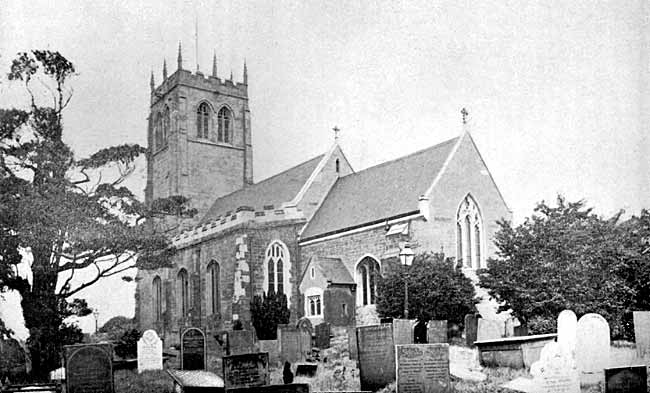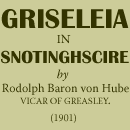< Previous | Contents | Next >
The church of St. Mary, Greasley

South east view of St MAry's church, Greasley.
The Rev. J. Charles Cox, the learned author of Notes on the Derbyshire Churches, gives the warning, that the dedication of a church should never be taken for granted from County Gazetteers or Directories. Dedications to All Saints and to St. Mary should be viewed with some suspicion until fairly established, for in the time of Henry VIII. the dedication festivals or wakes were often transferred to All Saints’ Day and Lady Day, in order to avoid a multiplicity of holidays, &c., &c. The Village Feast of Greasley not being among those which have been so transferred, the dedication of our church to St. Mary may reasonably be taken as being the correct one. We know not when or by whom our church was founded. It may have been by some early Bishop of the then Diocese; and it may be owing to the munificence of some great Saxon Thane of the Mercian Kingdom, in which this county then was; or to some converted Danish noble, who placed the church centrally in his large domains to be as nearly as could be equidistant for his dependents from every part of it. It appears to us that it was not only the founding of a church hut of a parish, and that probably the large property was subsequently alienated or divided into parts, and was ‘then acquired by those owners whom we find mentioned in Domesday, otherwise Hemshel and the townships of Watnall, Kimberley, and Brinsley might not have been in the parish. We conjecture that the parish was founded at latest in the time of King Canute if not before then, and possibly the first church here may have been a temporary structure, on the site of which our parish church was erected. Nevertheless, since we have the place names of Church Close and of Gospel Close in the parish, it may be that a temporary church may have been in one of those two Closes, and not on the site where our parish church stands. Another reason for our conjecture that the parish will have been founded when the whole territory belonged to one owner is, that no one of those mentioned in Domesday is known to have been entitled to a claim of part of our church, as for instance in Wandesley and in Trowell, in which parishes there were claimants for half a church. What we know for certain from Domesday is, that when the Survey was taken Ulfi was found to have been at Greasley from the Confessor’s time, and that the church and a priest were then here. It might be said that possibly Ulfi had founded the church, but then he could not have been the founder of the parish, since he had no authority over the proprietary of the other townships of the parish, which belonged to other owners, and that brings us back to the earlier presumption.
There is nothing to shew what the original type of the architecture of the church may have been, but it seems certain that the ground plan has never been altered. Probably it consisted of a chancel, nave, and a small tower, and the masonry was of a very primitive kind. The remains can even now be seen outside the chancel, especially the east end of it. It was nothing but a good thickness of undressed stones put together, with fine earth abundantly washed in between them, and the very irregular joints afterwards pointed with mortar. It is the oldest part of the church, and bears marks of alteration in the windows. Both the north side of the chancel and the east end of the north isle of the church were in 1882 found to have no mortar in the foundations, when the walls had to be underpinned for the excavations required for the new heating chamber. The chancel walls especially were even in 1896 found of the worst construction for about eight or nine feet upward from the foundations, and required great quantities of liquified mortar and cement to be poured into solidify them. The walls of the nave were of much later construction, but although better, yet also defective. The outside stones are of properly dressed and durable material, but the inner sides of the walls are not so, and evidently required being plastered over like the chancel. It appears from G. S. Tyack that the appellation “nave” was given to that part of a church from comparing the church with a ship, though his reference for it to the apostolic constitutions may not be the most acceptable one, and it is by himself admitted to be of a debated age. The floors were either unpaved, or where they were not so, were paved with either stones or tiles, and consequently very cold to the feet, and possibly they were not floored at all. Both in churches and in private houses the floors were strewn with rushes, arid Tyack refers for it to Thomas Newton’s “Herbal to the Bible,” published in 1587, in which Newton speaks of “sedges and rushes, with the which many in the country do use in summer time to strawe their parlours and churches, for pleasant smell, &c” Tradition says that rushes were in use in Greasley Church, and that they were grown in a very low laying piece of land in the second field south from the church, now forming part of Mr. Foster’s farm of Moorgreen.
The church must necessarily from time to time have undergone serious repairs and alterations or restorations of the earlier ones of which we have no knowledge, except from an evidence on the South side of the chancel, where there are proofs of earlier windows. Probably the church was in the best early condition in Nicholas de Canteloupe’s time. It is not likely, we conjecture, that the founder of Beauvale Priory would have left his own church, adjoining his castle, in a condition at variance with the greatest event of his life, when on the 9th December he had that distinguished assembly of high ecclesiastics and of noblemen here, who witnessed his Priory foundation charter. Moreover, during the last restoration of St. Mary, fragments of earlier windows were recovered, which were undoubtedly of 13th century work, and were semi-trefoil headed. To retain some of these fragments of the early work we have had a vestry window constructed from them, which exhibits them just as they were found. At that early time too, the windows must have been filled with stained or painted glass, fragments of which adhered in the grooves of the stonework which was recovered. These fragments of ancient glass however, when closely examined, did not only shew the kind of glass which had been used, but that they must have been subjected to great heat. That fact led us to conclude that the church must at some early time have suffered from an unrecorded fire, and this supposition became a certainty when the upper part of the east end of the chancel had in part to be taken down to make room for the new east window, when some six or eight feet downward from the roof a large lump of strangely shaped lead was found in the masonry. It had taken the shape of the bed which it found among the poorly put together stones and rubble, and must have run down in a molten state from the roof.
Thirty-nine years after the foundation of Beauvale Priory we meet with the information that there was an altar (probably a side altar) of St. James in our church. We gain this information from the Borough Records, which give the copy of a will concerning a testamentary burial. It is the burial of a Wolaton of the Wolatons mentioned in Watnall, and is as follows
“In Dei nomine, Amen. Ego Johannes de Wolaton condo Testamentum meum in huno modum. Imprimis lego animam meam Deo et Beatae Mariae, et omnibus sanctis Dei, et corpus meum ad supeliendum in Ecciesia de Greseley coram altari Sancti Jacobi. Item, lego, nomine principalis mei, meliorum equum meum. Item, lego in cera circa corpus meum comburendum, decem libras cerae. Item, do et lego Marjoriae uxori meae omnia bona et catella mea. Item, Priori de Bellavalle XX’s. Item, Fratribus Minoribus de Nottingham xld. Item, Fratribus Ordinis Carmelitarum ejusdem vilke xld. Item, Vicario Ecclesiae de Griseley XId. Item, Domino Thomas presbitero ejusdem villae XIId. Item, duobis clericis, utrique VId. Item, fabricae ecciesiae XId. Item, pauperibus istius parochiae. dimidiam marcam. Et ad istud testamentum fideliter faciendum et exequendum, ordino et constituo principalem executricam meam Majoriam uxorem meum, ac etiarn Willelmum fihium meum et heredam, necnon et Willelmam, flulium Georgii Charneles, coad jutorem corum. Datum apud Watnow, quinto nonas Maii, anno Domini Millesimo CCC LXXXI.”
Which is:—
“In the name of. God, Amen. I, John de Wolaton, make my testament in this manner. First, I leave my soul to God and St. Mary and to all the saints of God, and my body to be buried in the Church of Greasley before the altar of St. James. Also, I leave, in the name of my principal my best horse. Also, I leave in wax to be burned about my body, ten pounds of wax. Also, I give and bequeath to Margery, my wife, all my goods and chattels. Also, to the Prior of Beauvale, 20s. Also, to the Friars Minor of Nottingham, 40d. Also, to the Friars of the Carmelite Order of the same town, 40d. Also, to the Vicar of the Church of Greasley, 40d. Also, to Sir Thomas, priest of the same yule, 12d. Also, to two Clerks, 6d. each. Also, to the fabric of the Church, 40d. Also, to the poor of that parish, half a mark. And for faithfully making and executing this testament, I ordain and constitute my principal executrix my wife Margery, and also William my son and heir, as well as William, the son of George Charneles, their coadjutor. Dated at Watnow the fifth of the nones of May, in the year of the Lord One thousand three hundred and eighty-one.”
